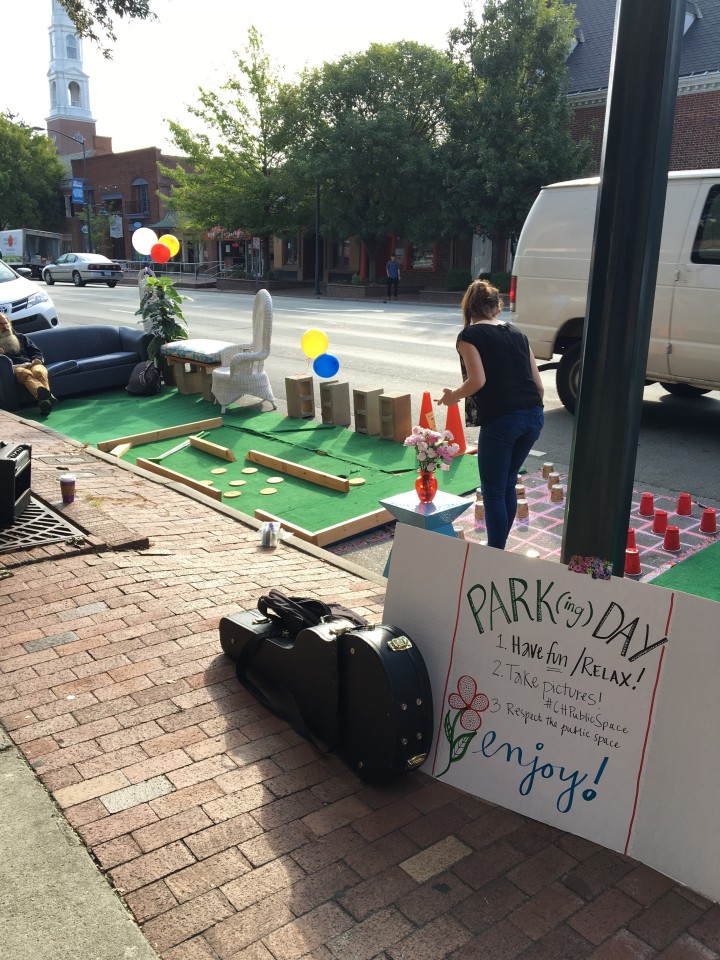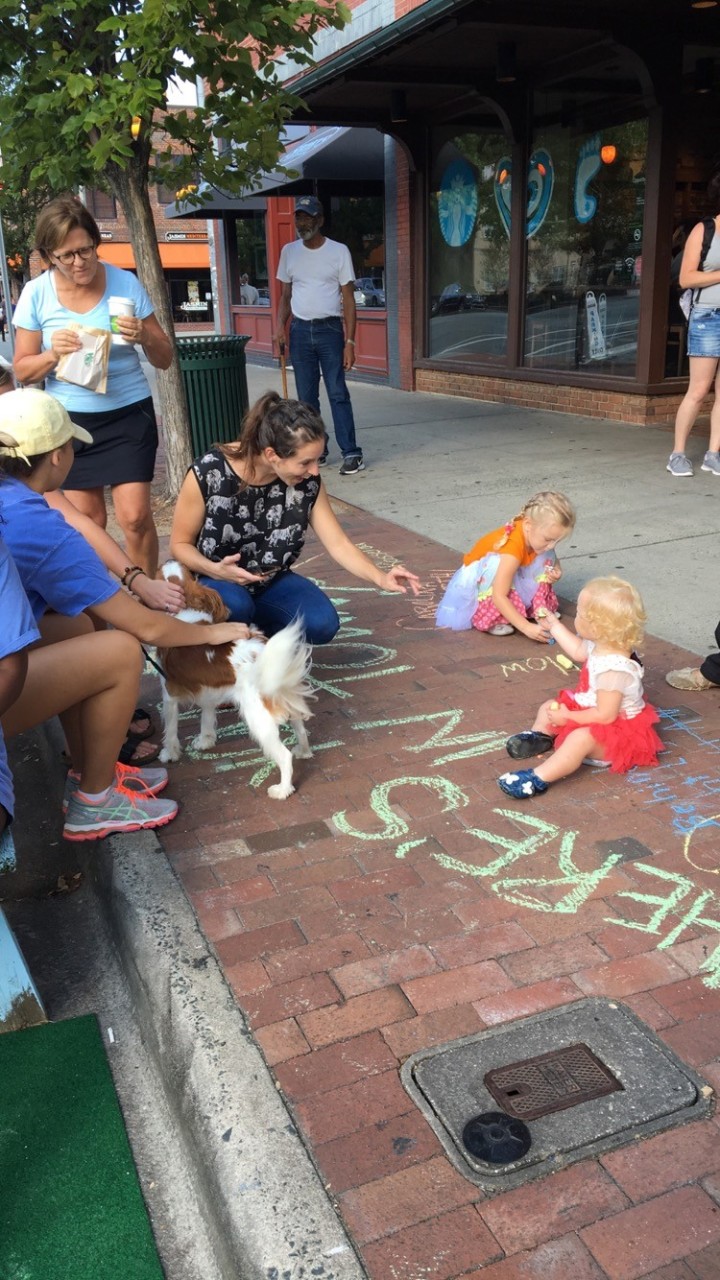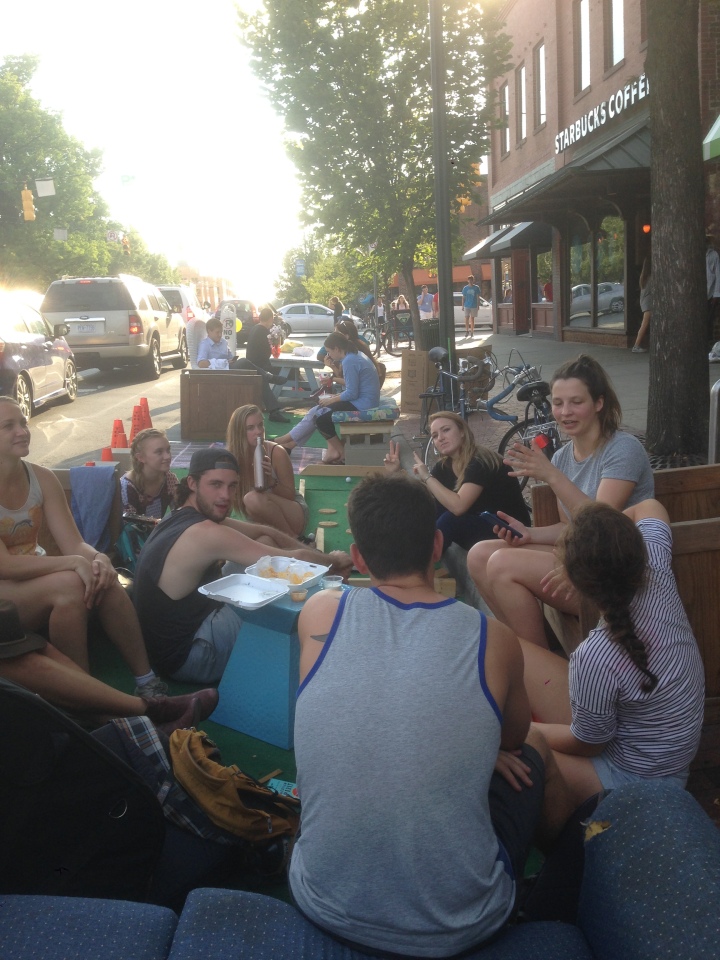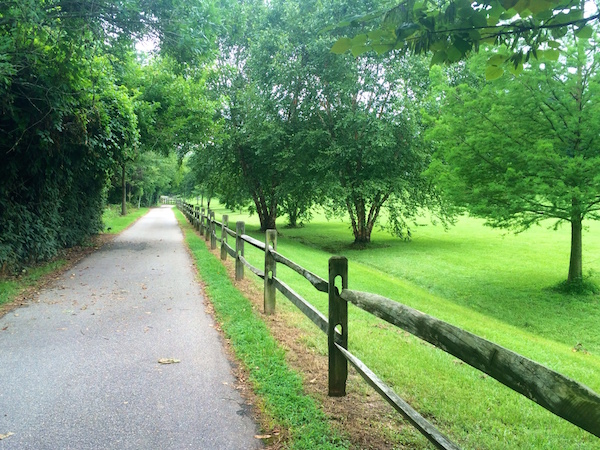How should we use public space in downtown cores? What is the social role of parks? What form can community action take?
Angles sat down with environmental studies and city planning student Caroline Lindquist, a senior undergraduate at UNC-Chapel Hill, to find out. We discuss the parklet she and her friends designed, built, and enjoyed on September 16th, known fondly by guerrilla urbanists throughout as “PARK(ing) Day”.
Angles: What is PARK(ing) Day?
Caroline Lindquist: PARK(ing) Day is an “annual open-source global event” where citizens transform parking spaces into temporary public spaces or parklets for the day. The event began in 2005 in San Francisco with a design studio called Rebar, that created its own parklet for a day. The mission of PARK(ing) Day is “to call attention to the need for more urban open space, to generate critical debate around how public space is created and allocated.”
A: How did you set up the park? Did you need permission to use the space?
CL: To build the Chapel Hill parklet, we gathered our group of friends who studied sustainable community design through the Burch Study Abroad Seminar in Spain and Germany in 2015. We all brought different items from our houses such as carpets, plants, chairs, sofas, tables, anything that we thought could help make a fun public space. We then bought two big rolls of astroturf and rolled them out to lay the groundwork for the parklet (because what’s a park without some green?) After arranging basic seating, we drew a checkerboard on the pavement with chalk and added a little putt-putt green to encourage activity in the space.

Did we need permission? Technically no. The original creators of Parking Day, looked at the zoning code in San Francisco and other cities and saw that as long as you pay the parking meter, you can use the space however you want. The Director of the Chapel Hill Downtown Partnership, Meg McGurk, was extremely supportive and encouraging of PARK(ing) Day. Meg went out of her way to reserve parking spots for us, pay the meter, and even provide Starbucks gift cards for anyone who visited the park to use.
A: Who were some of the people who visited the park?
CL: The type of people who used the park varied throughout the day. In the morning, the parklet was mainly occupied by our set-up crew, some folks experiencing homelessness who helped us set up the parklet the year before, moms with young kids, and coffee shop patrons.

In the afternoon, our friends stopped by, along with other UNC students, and those who heard about the event through social media or word of mouth.
By the evening, the sidewalks were heavily populated, since there was a home football game the next day. That was when more families and adults visited the parklet.

A: How was the space used throughout the day? What was the space like at 9am compared to 5 in the afternoon?
CL: Throughout the day, the space changed based on the sun orientation and the people who used the parklet. At 9am, the space was very basic with a few spots for seating, a picnic table, some couches, a bench. At mid-morning, we added balloons on the ‘No Parking’ cones to make the space more celebratory and inviting. We also added sidewalk chalk, which attracted some of the younger children walking by. In the afternoon, a friend brought by a foosball table and a soccer ball. We turned the astroturf section of the parklet into a mini soccer field using the ‘No Parking’ cones for goals.
A: What do you hope creating the parklet accomplished?
CL: I think this parklet showed people how much public space is devoted to the automobile (the sheer size of a parking spot is statement enough). Many people could not believe that all the parklet space was just two parking spots.
The parklet was a testament how public spaces strengthen community by encouraging interaction between different members of society (students, children, professionals, homeless, elderly) that may otherwise never meet.
The park also encouraged people to take more ownership of their city by transforming spaces to better reflect community values.

A: What urban designers inspire you?
CL: Though she’s not a designer, Jane Jacobs is one of my greatest inspirations. She was a journalist, author, and activist who criticized urban designs of the day, saying that they did not reflect the needs of city dwellers. The urban realm should be designed to the human scale to encourage ‘eyes on the street.’
Ghigo DiTomasso, a professor of mine at Berkeley is another major source of inspiration. He works for Gehl Studios, a world-renowned urban design firm, on activating public spaces and using tactical urbanism.
Lastly, Thomas Woltz, a landscape architect has inspired me with is urban design projects (such as the Hudson Yards project in New York City) because of the way he focuses on revealing the intersection between landscape ecology and cultural history with his work.
A: What projects are you working on right now?
CL: Right now, I am doing an independent study on the psychology of biophilic urban design. My work is focused on understanding the mental health benefits of integrating nature into cities as well as the psychology behind designing successful public spaces. I am using Dix Park in Raleigh as my case study, which was a mental health hospital before the land was bought by the City in 2015. I am also serving on the Dix Park Master Plan Advisory Committee, where I have the opportunity to help with the planning process and design of the new park.

About the Author
Caroline Lindquist is a senior at UNC majoring in Environmental Studies and minoring in City and Regional Planning. Her primary interests are biophilic design, tactical urbanism, and landscape architecture. She has spent the past two summers studying renewable energy in Spain and Germany and studying Urban Design at UC Berkeley. Caroline currently serves on the Dix Park Master Plan Advisory Committee for the City of Raleigh.
Feature Photo: Caroline Lindquist


One thought on “Reviving Wasted Pavement”
Comments are closed.